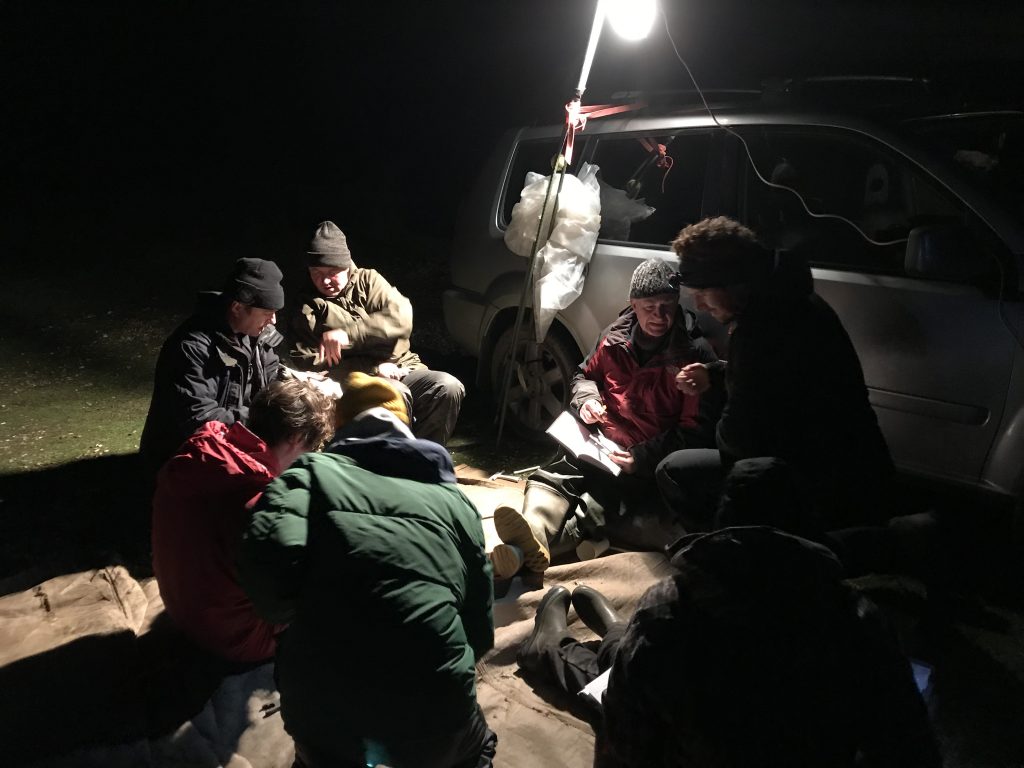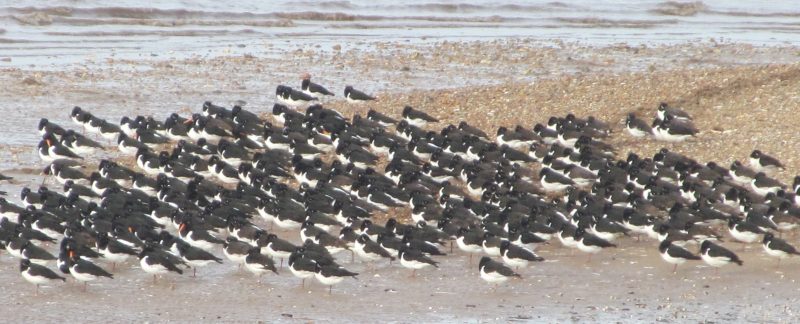Weather forecast
Saturday – strong winds
Sunday – less wind with rain
Recce and plan for the weekend
The original plan for the weekend, based on the timings for high tide and sunrise, was resighting on Saturday morning, mist netting on Saturday evening and a cannon net attempt on Sunday morning. However, the weather forecast soon made it clear that mist netting was not going to be an option for Saturday evening so a second plan was made which included a cannon net attempt on the rising tide on Saturday afternoon.
Aron undertook recces of Snettisham and Heacham beaches at both high tides on Friday 10 January to explore catching attempts for the weekend. On Heacham North North beach at dawn, Aron found a high tide roost of 120 Oystercatchers and 40 Curlew with small numbers of Sanderling and Turnstone. Walking down to Heacham South beach, Aron found a further roost of 400 Oystercatchers in the middle of the bay. Returning to Heacham South beach at 15:30, Aron watched as 7−800 Oystercatchers came onto the beach forming a high-tide roost.
Friday 10 January
Ron prepared a scrumptious supper of baked potatoes and vegetables followed by apple crumble, catering for the various dietary requirements of the group which was appreciated by all. This provided a great start to the weekend, sharing a meal whilst catching up with old friends and meeting new ones. Intense discussions then took place between the cannon net licensees and the two trainees to form a plan which would maximise the use of time on the following day without completely exhausting the participants. A plan was hatched from the discussions and a briefing given to the team by Guy. The possibility of a catch of Oystercatchers on Saturday evening depended on a very narrow window due to the forecast of very strong winds. The plan was to set two large-mesh, narrow nets at the bottom of the steep beach as this would be the only opportunity for a safe catch. Minimal wave action at the bottom of the beach would avoid the effects of longshore drift on the birds. Oystercatchers are the only waders which are safe to catch in such strong winds. The ideal catch would therefore be taken around two to three hours before high tide with the team ringing and processing the birds in the dark.
It was agreed that the team would need to leave the base house at 11:15 in order to set the nets and have left the beach well before any birds were starting to arrive. It was agreed that there was a window of opportunity for recceing the beaches and for resighting of colour-marked birds on Saturday morning for those keen enough to make an early start. Other members of the team were needed back at base for various tasks including packing the trailer, preparing breakfast and chopping down a tree in the garden.
Saturday 11 January
Three teams left the base at 06:30 with the aims of undertaking recces on Snettisham and Heacham NN beaches and to look for colour-marked birds. A third team headed to RSPB Snettisham to look for colour-marked birds on the pits.
Small numbers of Curlew were found in the field next to the RSPB carpark but no colour-marked birds at Heacham NN where the usual Turnstone flock was not to be seen. The team at the pits were disappointed to find that there were few waders around either on the pits or on the mudflats. The first catch of the trip was a Blue Tit which was flying around inside the Rotary hide. This was safely caught and released into the open air!
With the trailer packed and the team fed, the group piled into five cars and headed to Heacham. Unfortunately, there was a small delay at the gate along the back of the seawall as the key wouldn’t open the padlock. We later found that the padlock had been changed for the winter! A quick turn-around was necessary to retrace our way back to Snettisham with two cars and a trailer driving to the catching site and the rest of the team enjoying a brisk walk along the beach.
Two narrow nets were set at the bottom of the steep beach as planned with grot stretching almost from Snettisham to Heacham to disguise the net. Narrow nets with full cartridges should enable the net to go out despite the strong wind. Key people then remained on the beach with the rest of the team returning to the cars behind the seawall ready for a long (and cold) wait. Guy and Aron (with the firing box) were stationed towards Snettisham with Ros and Lizzie towards Heacham, all looking along the net line to watch for birds coming up the beach and to check for birds in safety. Nigel was stationed on the seawall looking at the net from behind to monitor which net the birds were coming into.
Initially, the birds were spread out over the mud in all directions. As the tide approached a pre-roost of Oystercatchers began to take shape at the Heacham end of the nets as birds began to congregate in front of the decoys. The birds then walked up the beach, in a V-shape as the tide came in, in text book fashion. With information from Nigel as to which net the birds were in, Aron and Guy kept their nerve, allowing the birds to come up the beach, thereby maximising the catch. The team at basecamp were on tenterhooks, waiting for a signal from the beach, worried that the moment would have gone (along with the birds!). Finally, the button was pressed and the net went out across the birds with the team racing over the sea wall to the birds. This moment was later described by Ian (on his first Wash trip) ‘The moment I ‘went over the top’ and saw the seething mass of black and white I just thought Christmas had come again!‘.
With the adrenaline running high the team worked really well to lift the birds onto covering material and safely up the beach out of reach of the incoming tide. With a catch of over 250 Oystercatchers weighing on average about 500 g, the total weight of the birds was in excess of 130 kg! The birds were placed in boxes on the beach and then carried over the seawall to be transferred into keeping cages. Once the nets had been taken up and all the equipment carried up the beach, people were sorted into a ringing team and two processing teams to enable the birds to be ringed and processed in as short a time as possible. Unfortunately, lifting the gear in the dark resulted in the loss of a projectile which could not be found despite a search the following morning. A good find for a metal detector enthusiast!
Every bird was ringed and processed well inside the four-hour time limit. The birds had been caught two hours before high tide so that they would have been roosting during the period of time that they were in our care. The birds were almost all adult birds with a small number in suspended moult, possibly indicating poor feeding conditions for some of the birds.

This was the first significant cannon-net catch for WWRG during the current winter period. It proved to be a very successful catch comprising a good winter sample of Oystercatcher. The team celebrated with a supper of fish and chips from a very obliging chip shop in King’s Lynn which fried 21 fish (including three without batter) in a surprisingly short time and provided free drinks as well.
Catch total:
| Species | New | Re-trap | Total |
| Oystercatcher | 180 | 82 | 262 |
| Species | Adult (8) | Immature (7/8i) | Juvenile (5) |
| Oystercatcher | 236 | 24 | 2 |
Sunday 12 January
Two groups went out resighting whilst other members of the team stayed at the base house to sort out the kit form the previous evening and to do some data checking tasks. Dave returned to his tree chopping exercise. One group checked out the pits at RSPB Snettisham where the birds were once again absent despite a much higher tide, remaining instead on a distant sand bar. Nigel, with a small group, went to check on the newly created pools on Ken Hill which now look to be good habitat for waders.
Resighting totals for the weekend:
| Species | Sightings | Individuals | WWRG | Non-WWRG |
| Curlew | 18 | 13 | 18 | 0 |
| Bar-tailed Godwit | 8 | 8 | 7 | 1 |
| Redshank | 1 | 1 | 0 | 1 |
| Total | 27 | 22 | 25 | 2 |
I will leave the last word to Ian ‘A really top weekend and I know that I have been really spoilt, it will take a long time to come anywhere near that experience again‘.
Thanks to everyone involved for their hard work and good company.

